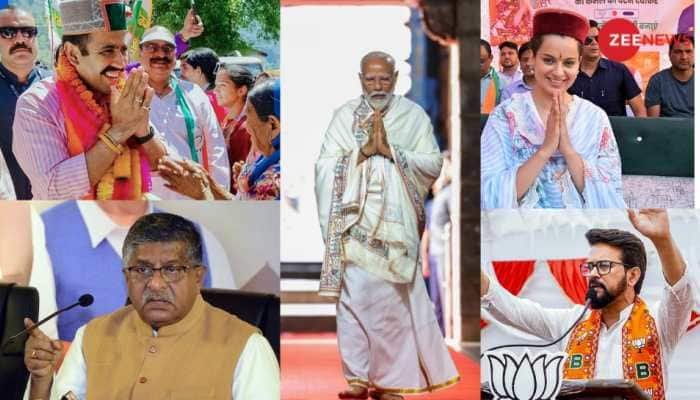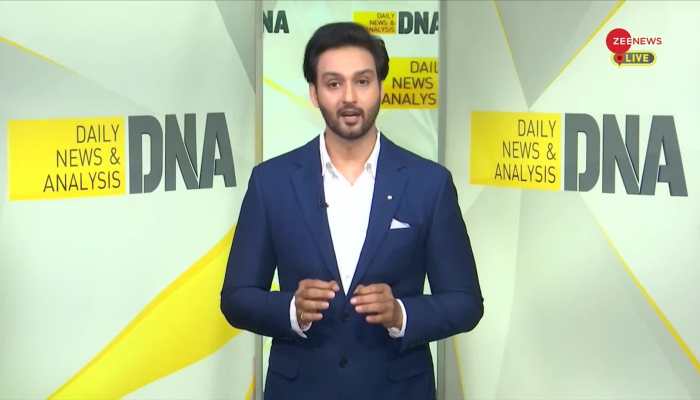Yearender 2018: Heartbreak for BJP in Hindi heartland, Congress-mukt northeast
Here’s a look at 10 major political developments of 2018, which could even turn out to be the defining moments of the Indian polity in 2019, when the country goes for Lok Sabha elections.
Trending Photos
)
The year of 2018 was a year of major political developments in India. From the controversial dissolution of Jammu and Kashmir Assembly by Governor Satya Pal Malik to the resurgence of the Congress party in states of Madhya Pradesh, Rajasthan and Chhattisgarh, India witnessed a string of developments that altered the political landscape of the country. Apart from these, Prime Minister Narendra Modi-led NDA government, which was elected in 2014 with a thumping majority, also had to face a no-confidence motion, which also turned out to be the first major show of opposition unity against the Bharatiya Janata Party (BJP).
Here’s a look at 10 major political developments of 2018, which could even turn out to be the defining moments of the Indian polity in 2019, when the country witnesses its next Lok Sabha election:
1. Assembly elections 2018 - Tripura, Meghalaya, Nagaland: The results of the Assembly elections in northeastern states of Tripura, Meghalaya and Nagaland were declared on March 3, 2018. The most significant of the three was the result of Tripura Assembly elections, where the BJP decimated the Left Front by securing a comfortable majority. After a fierce campaign, the BJP managed to bag 35 seats, thereby securing a comfortable majority in Tripura. The two-decade old Manik Sarkar government was toppled and Biplab Kumar Deb was installed as the new Chief Minister of the state. In Nagaland, the government was formed by the Nationalist Democratic Progressive Party (NDPP) while the National People’s Party was voted to power in Meghalaya.
2. Assembly elections 2018 – Karnataka: The most interesting electoral battle of 2018 was fought in the southern state of Karnataka, which witnessed a three-corner contest comprising the Congress, the BJP and the Janata Dal Secular (JDS). The BJP emerged as the single largest party by winning 104 seats while the Congress and the JDS bagged 78 and 37 seats, respectively. But even as the results were being declared, the Congress and the JDS sprung in action and declared that they would join hands to form a coalition government in the state. However, drama unfolded when Karnataka Governor Vajubhai Vala invited BJP’s BS Yeddyurappa to form government in the state, and gave the party 15 days to prove its majority. The move was challenged in the Supreme Court, which conducted a midnight hearing. Though the top court declined to stop Yeddyurappa’s swearing-in ceremony, but reduced the time limit for floor test to just 24 hours. After days of resort politics, allegations and counter-allegations, Yeddyurappa-led BJP lost the floor test and he resigned after an emotional speech. JDS leader HD Kumaraswamy was later sworn in as the Chief Minister of Karnataka.
3. Assembly elections 2018 - Madhya Pradesh, Rajasthan, Telangana, Chhattisgarh, Mizoram: The results of the Assembly elections in Madhya Pradesh, Rajasthan and Chhattisgarh came as a shot in the arm for the Congress party ahead of the 2019 Lok Sabha elections. The grand old party, whose political existence had been questioned by many, managed to snatch power from the BJP in the three states. The BJP, which had been in power in both Madhya Pradesh and Chhattisgarh for almost 15 years, was dethroned by the Congress party. While the Congress managed to secure a comfortable majority in Chhattisgarh, it fell marginally short of majority in Madhya Pradesh and Rajasthan. Mayawati’s Bahujan Samaj Party (BSP) extended support to the Congress party, following which Kamal Nath and Ashok Gehlot were sworn in as the Chief Ministers of Madhya Pradesh and Rajasthan. Bhupesh Baghel was appointed as the Chief Minister of Chhattisgarh.
In Telangana, which witnessed its first Assembly elections, K Chandrasekhar Rao’s TRS retained power by securing a thumping majority. Following the declaration of the results on December 11, KCR declared that he would play an active role in national politics in the run up to the Lok Sabha elections 2019. Mizoram Assembly elections results, however, came as a setback for the Congress party as it was voted out of power to lose its last northeast bastion. Zoramthanga-led Mizo National Front emerged victorious and formed government in the state.
4. No-confidence motion: In July 2018, Prime Minister Narendra Modi-led NDA government at the Centre faced a no-confidence motion in the Lok Sabha. The motion was moved by former BJP ally Telugu Desam Party (TDP), and backed by opposition parties including the Congress and the Left. Even as the motion was introduced, the NDA already had 313 members in the House, which suggested they would sail through the same comfortably. The country witnessed a 12-hour debate in Lok Sabha, including assertive speeches by Prime Minister Narendra Modi and Congress chief Rahul Gandhi, among others. The issue of Rafale deal was also raised by the Congress president, who accused Defence Minister Nirmala Sitharaman and Prime Minister Modi of lying to the people of the country. Shortly after his speech during the no-confidence debate, the government of France issued a statement on secrecy pact between the governments of both the countries. While the government managed to defeat the motion comfortably, the opposition claimed that it was a “fight between majority and morality”.
5. Dissolution of J&K Assembly: In the month of June, the BJP decided to end its alliance with Mehbooba Mufti-led Peoples Democratic Party (PDP) in Jammu and Kashmir. The decision of the BJP-led central government to resume anti-terror operations after the holy month of Ramzan was considered to be the immediate breaking point for the unusual alliance. What followed was trading of charges between the two parties and resignation of the government. But five months after the development, a major political drama erupted in the state with Governor Satya Pal Malik deciding to dissolve the Assembly. His move came shortly after PDP supremo Mehbooba Mufti decided to stake claim to form government with the help of the National Conference and the Congress party. While the BJP backed the decision of the Governor, PDP, NC and Congress termed the move as “undemocratic”, citing that they had the required numbers for government formation. Jammu and Kashmir is slated to go for Assembly elections before May, 2019.
6. Tussle within NDA: The year has not been a comfortable ride for the BJP-led NDA government. The first setback for the alliance came in March when Telugu Desam Chief (TDP) chief N Chandrababu Naidu decided to walk out of it over the issue of special category status for Andhra Pradesh. His move was triggered by Centre’s refusal to grant special category status to Andhra Pradesh.
Another setback for the ruling alliance came from Bihar when Upendra Kushwaha’s Rashtriya Lok Samta Party left the NDA over the issue of seat sharing for Lok Sabha elections 2019. Accusing the BJP leadership of not paying heed to the demands of smaller parties, Kushwaha left the NDA even before the final seat sharing arrangement of the ruling alliance was announced.
The other factor that has been troubling the NDA for long is its constituent, the Shiv Sena. The party has been vocal in criticising Prime Minister Narendra Modi and his government’s policies. The latest issue that the Shiv Sena has taken up to target the NDA is Ram Mandir.
7. Mahagathbandhan in making: The BJP juggernaut, which started in 2014, made different opposition parties to join hands. They came together in an attempt to make the political permutations and combination adverse for the BJP and other constituents of the NDA. While the first show of strength of opposition parties was part of HD Kumaraswamy’s swearing-in ceremony, the real test happened in several byelections, held in seats like Gorakhpur, Phulpur and Kairana etc. The results of the byelections suggested coming together of opposition parties, who have usually been arch rivals – for instance the Samajwadi Party and the Bahujan Samaj Party – would make things tough for the BJP, which has been riding on Modi wave. And this led to the concept of Mahagathbandhan, which is yet to be formally constituted, in the run up to the Lok Sabha elections 2019.
A significant figure with regard to the making of Mahagathbandhan in 2018 has been Telugu Desam Party supremo and Andhra Pradesh Chief Minister N Chandrababu Naidu. The Andhra strongman has travelled to different parts of the country and made leaders of almost all major opposition parties. In 2018, Naidu met presidents of several parties and a number of senior politicians, including Congress chief Rahul Gandhi, DMK president MK Stalin, Karnataka Chief Minister HD Kumaraswamy and Trinamool Congress supremo Mamata Banerjee.
Notably, Telangana Rashtra Samithi chief K Chandrasekhar Rao has also met several politicians, including Mamata Banerjee and BJD’s Naveen Patnaik, in his attempt to form a non-BJP and non-Congress federal front.
8. BSP-SP alliance: One of the most remarkable political developments that happened in 2018, and that could also set the course of Indian polity in 2019, was the coming together of two arch rivals – the Bahujan Samaj Party (BSP) and the Samajwadi Party (SP). The impact of the BSP-SP was clearly evident when the BJP was defeated in its bastions of Gorakhpur and Phulpur. While a party like BSP plays a key role in states like Madhya Pradesh and Rajasthan as well, its joining hands with the Samajwadi Party makes the political battle in Uttar Pradesh extreme crucial. The state sends a total of 80 MPs to the Lok Sabha, and the SP-BSP alliance may decide the fate of the next government at the Centre.
9. Call for Ram temple ordinance: After the Supreme Court deferred the hearing in Ayodhya Ram Janmabhoomi-Babri Masjid title case till January 2019, the clamour for an ordinance on the construction of Ram temple grew in all corners of the country in 2018. Right-wing groups like the Rashtriya Swayamsevak Sangh (RSS) and the Vishwa Hindu Parishad (VHP) even converged to Ayodhya to assert their demand for speedy construction of the temple. Political parties like the Shiv Sena also organised a large-scale event in Ayodhya, demanding that an ordinance be brought by the government to start the construction of Ram temple. However, the BJP leadership and the government declared that they would wait for the hearing in Supreme Court and not take the ordinance route as of now.
10. Rahul hugs Modi: While the BJP-led NDA comfortably sailed through the no-confidence motion brought by the opposition parties in 2018, it was Rahul Gandhi’s hug to Prime Minister Modi that grabbed the headlines and prime time all over news platforms. After a fiery speech, wherein the Gandhi scion talked about Lord Shiva, Hindutva and Hindustan, he walked to the chair of the Prime Minister. He gestured Modi to stand up, but even before the latter could react to the situation, the Congress chief bent and gave a hug to the Prime Minister. The moment was caught on camera and went viral immediately across social media and news platforms. However, soon after the Gandhi scion returned to his chair, he winked, and that came as a shot in the arm for the BJP, which targeted him over “frivolous and childish behaviour” on the floor of the House.
Live Tv







)
)
)
)
)
)
)
)
)
)
